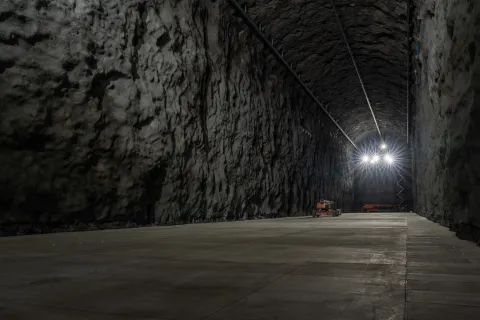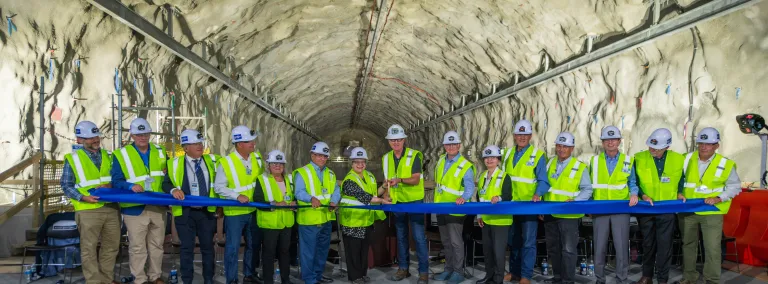Event marks excavation completion on colossal caverns for underground neutrino laboratory, DUNE
A massive milestone was celebrated on the international Long-Baseline Neutrino Facility/Deep Underground Neutrino Experiment that will tell us more about the universe and how it works.
A ribbon-cutting event was held today at the Sanford Underground Research Facility (SURF) in Lead, S.D. to mark the completion of excavation work for the Long-Baseline Neutrino Facility/Deep Underground Neutrino Experiment (LBNF/DUNE), an international project led by the U.S. Department of Energy’s Fermi National Accelerator Laboratory. The “Into the Depths of Discovery” event, hosted by Fermilab and the South Dakota Science and Technology Authority (SDSTA), was attended by supporters of the three-year excavation of the caverns, including state and federal leaders as well as officials from the Department of Energy.
“Today we celebrate this remarkable engineering feat and are grateful to the many people who worked to achieve this milestone,” said Derek Passarelli, DOE Principal Deputy Under Secretary for Science & Innovation. “This is an extraordinary achievement given the nature of the underground excavation. The LBNF/DUNE endeavor, involving partners from the nation as well as from around the world, will bring together our collective minds and talents focused on tackling the most challenging questions about how our universe works.”
The event occurred one mile beneath the surface at the northern detector cavern and marked the completion of excavation work on two seven-story caverns for housing particle detectors (see 2-minute animation), as well as a smaller central utility cavern. The two detectors will each be filled with 17,000 tons of liquid argon cooled to minus 184 degrees Celsius to record and study the rare interactions of neutrinos.
The international collaboration of DUNE scientists will study the behavior of mysterious particles known as neutrinos to address some of the biggest questions in science, such as why our universe contains matter, how an exploding star can create a black hole, and if neutrinos are connected to dark matter or other undiscovered particles.
“It is exciting to have so many people here today who have supported the excavation and construction of the project,” said Lia Merminga, director of Fermilab. “This is an important step in making LBNF/DUNE a world-class international underground science facility.”
The research conducted at Fermilab and SURF is the foundation for future technological innovation. The history of scientific research shows that discoveries made today have the potential to positively impact humanity for generations to come.
“This important milestone is a great way to celebrate the world-class research, innovation, education, and economic opportunities happening here at America’s Underground Lab,” said Mike Headley, laboratory director at SURF and the executive director of the SDSTA. “The research underway at SURF will extend well into this century; the impact of scientific advancements made here could last much longer. Our future is incredibly bright, and we are excited to help it unfold.”
Engineering, construction, and excavation teams have worked 4,850 feet below the surface since 2021 at SURF to prepare the space needed for the experiment. Over 800,000 tons of rock were excavated and moved from underground to an expansive former surface mining area known as the Open Cut. In order to accomplish this feat, construction crews dismantled heavy mining equipment and, piece by piece, transported it underground. Workers then reassembled the machinery and have been blasting and relocating rock ever since.
The U.S. Department of Energy’s Fermilab and SURF are working together for this international science project as part of a large collaboration comprised of more than 1,400 scientists and engineers from over 200 institutions in over 35 countries and the European Organization for Nuclear Research, known as CERN.
View the full recording of the event here. An additional release from Fermilab will include more photos and video from the event.

